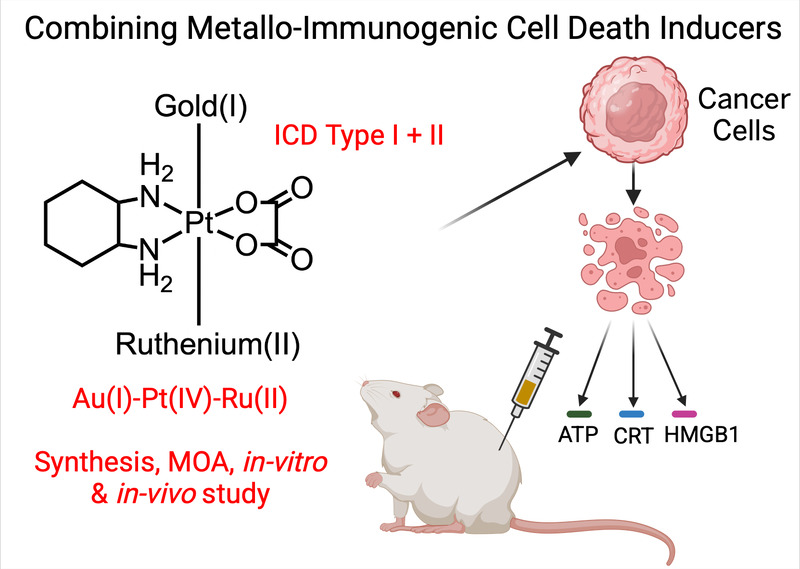Poster Presentation 21st International Conference on Biological Inorganic Chemistry 2025
Tri-Metallic Magic: Au(I)-Pt(IV)-Ru(II) Prodrug for Immunogenic Cell Death induction (#421)
Recent advancements in cancer therapy highlight the promising synergy between chemotherapy and immunotherapy.1 Particularly intriguing is the induction of Immunogenic Cell Death (ICD) that can trigger the release of damage-associated molecular patterns (DAMPs) from dying cancer cells, activating the immune system to target and suppress distant or metastatic tumors, thereby providing long-term immune protection.2
Several metal complexes have been identified as effective ICD inducers, showing promising results in enhancing immune responses.3 However, previous studies have not compared ICD capabilities between different metallodrugs nor explored the potential of conjugating multiple metal complexes into a single prodrug to assess whether the combination could provide performance greater than the sum of their parts.
This study aims to address this gap by combining distinct metal complexes into a single prodrug, enhancing tumor localization and immunomodulatory activity. We successfully conjugated ICD inducers to an oxaliplatin Pt(IV) scaffold, incorporating axial ligands derived from a gold(I) complex (SS-1) and a ruthenium(II) compound (plecstatin-1). Bi- and tri-metal derivatives were synthesized, purified, and fully characterized. The mechanism of action was investigated, and in-vitro and in-vivo studies were conducted to assess their potential as ICD inducers.
Our results show that these multi-metal complexes exhibit enhanced tumor localization and immunomodulatory effects compared to individual components or their co-administration. The combination of metal complexes in a single prodrug offers a novel approach to improve the efficacy of cancer therapy by harnessing the dual power of chemotherapy and immune activation. These findings provide a promising platform for the development of next-generation cancer treatments with enhanced therapeutic potential.

- Sordo-Bahamonde, Christian, Seila Lorenzo-Herrero, Ana P. Gonzalez-Rodriguez, Alejandra Martínez-Pérez, Juan P. Rodrigo, Juana M. García-Pedrero, and Segundo Gonzalez. “Chemo-Immunotherapy: A New Trend in Cancer Treatment.” Cancers 15, no. 11, 2023, 2912.
- Zhou, Jingyi, Gangyang Wang, Yinze Chen, Hongxia Wang, Yingqi Hua, and Zhengdong Cai. “Immunogenic Cell Death in Cancer Therapy: Present and Emerging Inducers.” Journal of Cellular and Molecular Medicine 23, no. 8 (2019): 4854–65.
- Zhang, Lingpu, Nicolás Montesdeoca, Johannes Karges, and Haihua Xiao. “Immunogenic Cell Death Inducing Metal Complexes for Cancer Therapy.” Angewandte Chemie International Edition 62, no. 21 (2023):